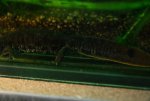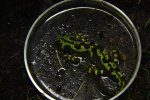garfield188
New member
- Joined
- Dec 22, 2011
- Messages
- 27
- Reaction score
- 0
- Points
- 1
- Country
- Netherlands
Hello caudata members, I have some questions about Triturus marmoratus and Triturus carnifex, which are now about 1,5 years old.
-At what length does Triturus marmoratus reach sexual maturity? The males I have here are now aproximately 12cm in length and my largest female is 13 cm.
-Is the Triturus carnifex showed on the picture a male? I wonder about this because he has a small crest of about 1mm in height, yet doesn't have a large cloaca at all.
-What is the best way to hibernate these species? And shouldn't you feed them at all during hibernation?
I have read a lot about these species on the internet, but i would like to hear your opinion as well.
-At what length does Triturus marmoratus reach sexual maturity? The males I have here are now aproximately 12cm in length and my largest female is 13 cm.
-Is the Triturus carnifex showed on the picture a male? I wonder about this because he has a small crest of about 1mm in height, yet doesn't have a large cloaca at all.
-What is the best way to hibernate these species? And shouldn't you feed them at all during hibernation?
I have read a lot about these species on the internet, but i would like to hear your opinion as well.




